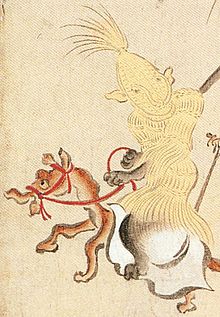Bake-zōri
The Bake-zōri ( Japanese. 化 け 草 履 , to dt. "Ghost Sandal") is a fictional being from traditional Japanese folklore and belongs to the group of Yōkai .
description
The Bake-zōri is described as a walking straw sandal that comes to life and makes inhabited houses unsafe. He has two arms and legs, but only one eye. He should especially at night running through the house and constantly "KARARIN, kororin, kankororin, Managu Mittsu ni ha ninmai" ( カラリン,コロリン,カンコロリン,まなぐ三つに歯二ん枚; to dt. "KARARIN, kororin, kankororin ! Please [give me] three eyes and two teeth! ”).
background
The design model was probably the zōri , traditional thong sandals made of woven rice straw . They consist of a sole and two straps that run between the big and second toes.
The oldest images of Bake-zōri can be found in a scroll from the Muromachi period . There a bake-zori in a rice-straw armor can be seen riding a horse-like dragon. The first representations of anthropomorphic bake-zōri come from the Edo period . But there are also traditions that describe Bake-zōri as a wooden geta, which is why it is sometimes assumed that the name "Bake-zōri" simply describes every type of inspired footwear.
The being Bake-zōri belongs to a special group of yōkai, the tsukumogami ( 付 喪 神 , dt. "Artefact spirits"): According to Japanese popular belief, household appliances and musical instruments of all kinds can turn into yōkai after 100 years, because too they have a soul. Bake-zōri also develop a life of their own when they announce their “100. Birthday ”, during this time it was too often ignored and felt useless. In retaliation for the neglect (and out of sheer boredom), they pursue and frighten house residents and walkers. Other bake-zōri seek out more tsukumogami and join forces with them. Or they leave the house and just run away.
literature
- Adam Kabat: も も ん が あ 対 見 越 入道: 江 戶 の 化 物 た ち . Kodansha, Tokyo 2006, ISBN 978-4-06-212873-5 .
- Shigeru Mizuki: 妖 鬼 化. 5 東北 ・ 九州 編 . Softgarage, Tokyo 2004, ISBN 978-4-86133-027-8 .
- Masaharu Takemura: ろ く ろ 首 考: 妖怪 の 生物学 . Bungei-sha, Tokyo 2002, ISBN 4835546350 .
- Michaela Haustein: Mythologies of the World: Japan, Ainu, Korea . ePubli, Berlin 2011, ISBN 3844214070 .
